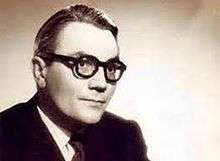André Hornez
| André Hornez | |
|---|---|
 Portrait of André Hornez. | |
| Born |
May 12, 1905 Lens, France |
| Died |
March 9, 1989 (aged 83) Le Perreux-sur-Marne, France |
| Burial place | Faverolles |
| Residence | Faverolles |
| Nationality | French |
| Occupation | Lyricist, Screenwriter |
| Years active | 1932-1983 |
| Notable work | C'est si bon (1947) |
| Style | Chanson, Operetta |
| Spouse(s) | Gisèle Fréry (m. 1963; his death 1989) |
| Children | 0 |
André Hornez (12 May 1905 – 9 March 1989) was a French lyricist and screenwriter.[1]
Lyricist of Paul Misraki in the years 1930-1940 for which he writes many songs lyrics like Qu'est-ce qu'on attend pour être heureux ? (1937), André Hornez then became the lyricist of Henri Betti in the years 1940-1950 for which he wrote especially the lyrics to C'est si bon (1947).
Biography
Born in Lens in 1905, André Hornez a passion early for architecture and writing. He finally chose writing. He began his career as secretary of Saint-Granier. For him, he writes books magazines and operettas. The author is also hired by Paramount company in Hollywood to write screenplays.
His first songs are composed by Paul Misraki and performed by Ray Ventura and Maurice Chevalier. As for Ray Ventura, they collaborate with lyricist for many years. Among the best-known songs from this collaboration are Ca vaut mieux que d'attraper la scarlatine (1936), Qu'est-ce qu'on attend pour être heureux ? (1937), Comme tout le monde (1938), Tiens, tiens, tiens (1939), Dans mon cœur (1940), Maria de Bahia (1946) and La mi-août (1950).
In 1936, the song Tant qu'il y aura des étoiles, performed by Tino Rossi, became a classic of French song. In the late 1930s, André Hornez also written for Rina Ketty (Sérénade sans espoir, 1939) and Johnny Hess (Je suis swing, 1939).
Screenwriter for film, he wrote a number of film lyrics like Avec son tralala sung by Suzy Delair in Quai des Orfèvres (1947) by Henri-Georges Clouzot. His songs are performed by Yves Montand (Moi j' m'en fous, Du soleil plein la tête), Lucienne Delyle (Mon cœur attendait, 1951), André Claveau (Malgré tout, 1951) or Line Renaud (Ni pourquoi ni comment).
In 1947, he collaborated for the first time with the composer Henri Betti him to write the lyrics to C'est si bon. This song became an international jazz standard from the 1950s.
A large majority of the author's songs were written for the cinema or for operettas. Several of his songs have become immortal French song.
André Hornez died in Le Perreux-sur-Marne in 1989 and is buried with his wife in the cemetery of Faverolles.
Personal life
André Hornez married July 5, 1963 in Boulogne-Billancourt with the dancer Gisèle Fréry (1929-2013), met on the operetta Baratin in 1949. His best man was Bruno Coquatrix. The couple had no children.
Respects
- December 18, 2003 was named a street in his name in Lens where he was born in 1905.
- May 12, 2007 was placed a commemorative plaque with his name on the facade of the building where he was born.
Filmography
Screenwriter
- 1936 : Les Deux Favoris
- 1937 : Le Chanteur de minuit
- 1938 : Mon curé chez les riches
- 1939 : Tourbillon de Paris
- 1943 : Feux de joie
- 1947 : En êtes-vous bien sûr ?
- 1950 : Nous irons à Paris
- 1950 : La Petite Chocolatière
- 1950 : Le Roi Pandore
- 1950 : Pigalle-Saint-Germain-des-Prés
- 1951 : Les Joyeux Pélerins
- 1951 : Jamais deux sans trois
- 1952 : Mon curé chez les riches
- 1953 : Moineaux de Paris
- 1956 : Baratin
Lyricist
- 1933 : Monsieur Bébé
- 1934 : La Prison de Saint-Clothaire
- 1935 : Folies-Bergère de Paris
- 1938 : Belle Étoile
- 1938 : Retour à l'aube
- 1947 : Quai des Orfèvres
- 1950 : Pigalle-Saint-Germain-des-Prés
- 1951 : Nous irons à Monte Carlo
- 1952 : Une fille sur la route
- 1953 : L'Œil en coulisses
- 1954 : Le Fil à la patte
- 1956 : Le Chemin du paradis
- 1956 : Et Dieu… créa la femme
Director
- 1936 : Les Deux Favoris, with Georg Jacoby
Operettas
- 1929 : Jim by Georges Ghestem, Opéra de Lille
- 1930 : Loulli by Georges Ghestem, Opéra de Lille
- 1936 : Normandie by Paul Misraki, Théâtre des Bouffes-Parisiens
- 1936 : Simone est comme ça by Raoul Moretti, Théâtre des Bouffes-Parisiens
- 1938 : La Féerie blanche by Casimir Oberfeld et Mitty Goldin, Théâtre Mogador
- 1948 : Le Chevalier Bayard by Bruno Coquatrix, Théâtre de l'Alhambra
- 1949 : Baratin by Henri Betti, L'Européen
- 1950 : M'sieur Nanar by Jean-Jacques Vital, Théâtre de l'Étoile
- 1953 : Mobilette by Henri Betti, L’Européen
- 1960 : La Petite Datcha by Georges Soria, Théâtre Gramont
References
External links
- André Hornez at the Internet Movie Database
- André Hornez at the Internet Broadway Database

- André Hornez at the AlloCiné
- André Hornez at the BnF
- André Hornez at the Discogs
- André Hornez at the Unifrance
- André Hornez at the Hall de la chanson
- André Hornez at the Ciné-Ressources
- André Hornez at the Les Archives du spectacle
- André Hornez at the Les Auteurs et Compositeurs de la Chanson Francophone
- André Hornez at the Les Gens du cinéma
- André Hornez at the Encyclopédie de la comédie musicale
- André Hornez at the Notre Cinéma
- André Hornez at the Geneastar